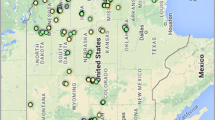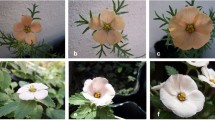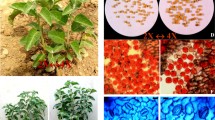Abstract
Intermatings between sexual diploids (2n=36) and facultative apomictic tetraploids (2n=4n=72) of Tripsacum dactyloides var. dactyloides, (L.), L., have been generated. Subsequent exchange and addition of genetic material between the two cytotypes, via a backcrossing program, provides one method for the manipulation of genetic elements involved in apomictic reproduction (diplospory) of this species.
Identification and development of fertile triploids, and their innate tendency to exhibit a high frequency of unreduced egg cells which remain receptive to fertilization by a sperm nucleus, allows for the unique development of B III (2n=3x+n) tetraploids by genome accumulation. The resultant B III progeny provide new breeding stock for investigating the inheritance and generation of such materials also allows for the occurrence of genetic recombination between sexual diploids and apomictic tetraploids. Potential use of fertile triploids, their tendency for genome accumulation and their use in exploiting apomictic tetraploid germplasm resources are also discussed.
Similar content being viewed by others
References
Bashaw, E. C. & K. W., Hignight, 1990. Gene transfer in apomictic buffelgrass through fertilization of an unreduced egg. Crop Sci. 30: 571–575.
Bashaw, E. C., M. A., Hussey & K. W., Hignight, 1992. Hybridization (N+N and 2N+N) of facultative apomictic species in the Pennisetum agamic complex. Int. J. Plant Sci. 153: 466–470.
Brown, W. V. & W. H. P., Emery, 1958. Apomixis in the Gramineae: Panicoideae. Am. J. Bot. 45: 253–263.
Burson, B. L., P. W., Voigt, R. A., Sherman & C. L., Dewald, 1990. Apomixis and sexuality in eastern gamagrass. Crop Science 30: 86–89.
Burson, B. L., 1992. Cytology and reproductive behavior of hybrids between Paspalum urvillei and two hexaploid P. dilatatum biotypes. Genome 35: 1002–1006.
Burton, G. W. & I., Forbes, 1960. The genetics and manipulation of obligate apomixis in common bahiagrass (Paspalum notatum Flugge). In: Proc. 8th Int. Grassland Congr., pp. 66–71. Alden Press: Oxford.
Burton, G. W. & W. W., Hanna, 1992. Using apomictic tetraploids to make a self-incompatible diploid pensacola bahiagrass clone set seed. J. Hered. 83: 305–306.
Dewald, C. L., C. M., Taliaferro & P. C., Dunfield, 1992. Registration of fertile triploid germplasm of eastern gamagrass. Crop Sci. 32: 504.
Farquharson, L. I., 1954. Natural selection of tetraploids in a mixed colony of Tripsacum dactyloides. Proc. Indiana Acad. Sci. 63: 80–82.
Farquharson, L. I., 1955. Apomixis and polyembryony in Tripsacum dactyloides. Am. Jour. Bot. 42: 737–743.
Hanna, W. W., J. B., Powell, J. C., Millot & G. W., Burton, 1973. Cytology of obligate sexual plants in Panicum maximum Jacq. and their use in controlled hybrids. Crop Sci. 13: 695–697.
Harlan, J. R., M. H., Brooks, D. S., Borgaonkar & J. M. J., deWet, 1964. Nature and inheritance of apomixis in Bothriochloa and Dichanthium. Bot. Gaz. 125: 41–46.
Harlan, J. & J. M. J., deWet, 1975. On O Winge and a prayer: The origins of polyploidy. Bot. Rev. 41: 361–390.
Heslop-Harrison, J., 1992. The reproductive versatility of flowering plants: An overview. In: Strategies of Plant Reproduction. Ed., W. J., Meudt. Allanheld, Osmun Publishers, London.
Kindiger, B., 1993. A technique for the preparation of somatic chromosomes of maize. In: The Maize Handbook, Eds. M., Freeling, V., Walbot. Springer-Verlag, New York, Inc.
Ozias-Akins, P., E. L., Lubbers, W. W., Hanna & J. W., McNay, 1993. Transmission of the apomictic mode of reproduction in Pennisetum: co-inheritance of the trait and molecular markers. TAG 85: 632–638.
Rutishauser, A., 1948. Pseudogamie und Polymorphie in der Gattung Potentilla. Arch. Julius Klaus Stift. Vererbungsforsch. Sozialanthropol. Rassenhyb. 23: 267–424.
Sherman, R. A., P. W., Voigt & B. L., Burson, 1991. Apomixis in diploid x triploid Tripsacum dactyloides hybrids. Genome 34: 528–532.
Taliaferro, C. M. & E. C., Bashaw, 1966. Inheritance and control of obligate apomixis in breeding buffelgrass, Pennisetum ciliare. Crop Sci. 6: 473–476.
Author information
Authors and Affiliations
Additional information
All programs and services of the U.S. Department of Agriculture are offered on a nondiscriminatory basis without regard to race, color, national origin, religion, sex, age, marital status, or handicap.
Rights and permissions
About this article
Cite this article
Kindiger, B., Dewald, C. Genome accumulation in eastern gamagrass, Tripsacum dactyloides (L.) L. (Poaceae). Genetica 92, 197–201 (1994). https://doi.org/10.1007/BF00132538
Received:
Accepted:
Issue Date:
DOI: https://doi.org/10.1007/BF00132538




